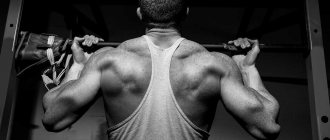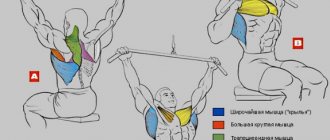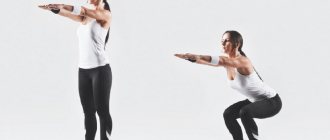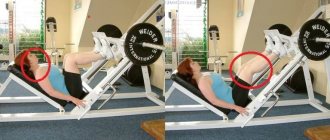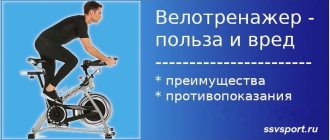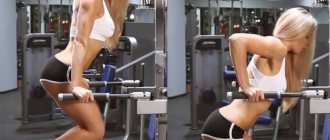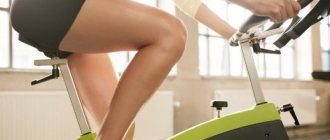An integrated approach to training
Pull-ups, like any other exercise, can provide little in terms of muscle growth without a number of other measures.
Number one among these measures is nutrition. Next comes sleep and lifestyle in general. Let's start with nutrition to keep things short and clear.
Eat like an elephant - you will be huge and strong
There is meaning and a piece of truth in this funny phrase. Eating a lot of calories will actually make you gain weight. If you do not exercise, fat will accumulate. If, with an excess of calories, you load the muscles to the fullest extent, it is the muscles that will grow.
And there is one more condition - the quality of the food. Depending on what is contained in the food, subcutaneous and visceral fat or muscle will grow more.
If your food is rich in protein, the muscle part of the body will receive building material. But without energy, muscles cannot work effectively. High-carbohydrate foods, in turn, are rich in energy contained in the chemical bonds between molecules. This energy will be spent during training, and its excess will be stored in the form of glycogen and used for fat synthesis. But there is little building material for muscles in carbohydrate foods, so they have nothing to grow from.
Hence the conclusion - you need both proteins and carbohydrates. Everything is simple here - there is material, there is energy - synthesis occurs. This is how our body works.
The best option is to calculate your daily diet in calories and grams of proteins, carbohydrates and fats. There is a lot of information in open sources about how to do this.
- Your first task is to make sure that the calories expended per day are less than the calories consumed. Then the excess calories will give growth.
- The second task is to decide how much protein you need to consume per day based on your body weight. And provide yourself with such a diet. Remember that protein is not only found in meat. Among other things, these are dairy products, eggs, fish and much more.
Compliance with the optimal amount of calories and BJU ratio will be called proper nutrition. Stick to it, and gaining mass on the horizontal bar will not take long.
However, it is worth saying that any organism has limits. Muscle can grow at a certain rate. And this speed at the first stage is limited by the concentration of growth hormones and testosterone. Each person's rate of muscle growth is individual. Therefore, do not be equal to your comrades - track your and only your results.
Lifestyle
By lifestyle I mean the ratio of sleep and wakefulness within a day, as well as physical activity.
Everything is clear with activity - the higher it is, the higher the calorie intake should be and vice versa.
You need enough sleep to feel good and energetic during the day. Some people say - sleep more and everything will be fine. But what matters is not so much the number of hours, but the quality of sleep.
After all, after a very long sleep a person may feel “broken.” This means that you either slept poorly or simply went over your quota. Be guided by sensations. Your task is to choose the number of hours that will give you the most comfortable feeling.
If you have mastered all of the above, let's start looking at pull-ups!
Wide-grip chest pull-ups
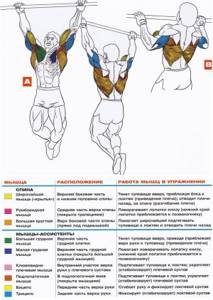
Main accent: paired round, top of lats, trapezoidal.
Execution: grab the bar with a grip approximately equal to the grip in the bench press with a barbell, while clasping the projectile with your thumbs from above - this better stretches the latissimus dorsi muscles. Without straining your biceps and squeezing your shoulder blades, pull yourself up, trying to touch the bar with the top of your pectoral muscles. Arch your back and look straight up. After pausing a little at the top point, return to the starting position.
Mass pull-up diagram
When talking about how to gain muscle mass on the horizontal bar, you should clarify that you will need to do different variations of pull-ups and muscle-ups.
To start, focus on pull-ups. This will be a kind of preparation. For example, you can exercise three times a week.
Let's designate training days with numbers:
- Pull-ups with a reverse narrow grip in three approaches for the maximum number of times (but not less than 10 per approach).
- Pull-ups with a wide straight grip on the back, the same amount.
- Pulls with a classic medium grip. We do “unloading”, 3 sets of 10 times.
The last day should be easy so that your muscles do not overwork. Try doing this for a month. In 30 days you will complete approximately 12-13 workouts, then, depending on your results, you can start working on weight.
Yes, you understood correctly, you will need to use weights.
Gradually begin adding additional pounds to your weight. These could be water bottles tied to your waist, a backpack with weight plates, or a classic weight vest. Or maybe you will use leg weights? Your choice.
The training scheme remains the same. On the first and second days, we reduce the number of repetitions in the approach to 6-8. The weight should be such that the last pull-up is difficult for you. The third day is left as a “fasting” day. That is, we work 10 times without weights or with light weights.
We perform all movements slowly, without jerking. If you weigh too many pounds, you won't be able to do all the reps smoothly. You'll have to move in jerks. People with connective tissue defects are at risk of pulling the muscles of the forearm and shoulder. Be aware of these risks and avoid sudden movements.
In parallel with weighted pull-ups, you need to begin to master the power output in different variations. It is better to practice outdoors, since the ceilings prevent you from fully performing exercises indoors.
Exercise on the crossbar regularly, fight laziness - then and only then will you get results. But there is still a nuance on which your progress depends.
There is one problem with exits - if you don't understand the technique, it will be difficult to make them. And it doesn't matter how strong your hands are. Everything will depend on the coordination of the muscles of your body.
What muscles work with different types of pull-ups?

Straight grip
First, let's look at pull-ups with an overhand grip. This is a classic version that is used in school lessons. A straight grip involves fixing your hands on the bar with your palms facing away from you. Thanks to this exercise, you can work the muscles on the back, biceps, triceps, forearms, and shoulder muscles. Such pull-ups, which muscles work in which, you already know, are classics with which you can begin your acquaintance with this exercise.
Reverse grip
The reverse grip is considered simpler than the straight grip. Therefore, many recommend it to beginners whose shoulders and back are not sufficiently developed, but still have a certain strength in their biceps. The exercise is aimed at working the biceps and broad back muscles . To perform it correctly, you need to turn your palms towards you and grab the bar, moving your shoulders back a little.
Parallel grip
A parallel grip is also called a neutral grip. In this case, one palm is turned towards you, and the other away from you, and mainly the lower sections of the latissimus muscles work. If you use a narrow grip, maximum amplitude and touch the bar with your chin, then the biceps will work, not the latissimus muscles .
The parallel grip is usually used to finish the workout after working the lats.
In addition to the grip method, which, as you already know, can be direct, reverse and parallel, which muscles swing during a pull-up may depend on other criteria:
- Grip width. With a medium grip, the hands are positioned shoulder-width apart, with a narrow grip, they are narrower. If we talk about a wide grip, then the distance between the hands on the bar will be significantly greater than the width of the shoulders.
- Upper body position: you can pull yourself up to your chest, to your chin, or behind your head.
These are the basic methods of pull-ups, although there are others that are more complex. These include one-arm, slam, dead, roll, and so on. But you should only switch to them if you can do classic variations of pull-ups. The same applies to weights, which can be used to increase the load.
Wide grip
When pulling up with a straight wide grip, the trapezius, upper part of the latissimus muscles, and round muscles swing well. When pulling up behind the head, the lower part of the latissimus muscles, trapezius, and paired round muscles work. This exercise is performed as follows:
- Grab the bar wide.
- When bending your arms, make sure that your forearms and the bar of the horizontal bar form a right angle, and your shoulders are kept parallel. The thumb should be next to the palm, and not wrap the ring around the crossbar.
- Raise your body, squeezing your shoulder blades until your chest touches the bar.
Narrow grip
With a straight narrow grip, the lower part of the latissimus muscles, brachialis, and serratus anterior muscles swing. The reverse close grip is an ideal exercise for working the biceps . The exercise is performed like this:
- Grab the bar.
- Your palms should almost touch each other. Hang on the horizontal bar and arch your back slightly.
- Cross your legs so that your body does not sway - this will make the exercise more difficult.
- Bend your arms, trying to reach the bar with your chin.
- Start the reverse movement. You need to lower yourself smoothly, without jerking, fully extending your arms.
The reverse close grip works the biceps and lower lats. In this case, the athlete needs to touch the bar with the lower part of his chest. The technique for performing the exercise is as follows:
- Grab the horizontal bar with a reverse grip: palms facing you, thumb should close the bar with a ring.
- You need to lift your body using your shoulder blades. You should feel how they work when mixing. Try to reach your chest to the top point of the horizontal bar.
- Smoothly return to the starting position.
Medium grip
With a medium grip, the shoulders, biceps, triceps, forearm flexors and back are pumped. It is performed in the same way as the previous version, but the hands are shoulder-width apart. You should touch the bar with your upper chest. At the bottom, the arms straighten completely smoothly. With a reverse grip with this position of the hands, the biceps and latissimus muscles swing. Such pull-ups on the horizontal bar, which muscles work in which, you already know, are considered classic.
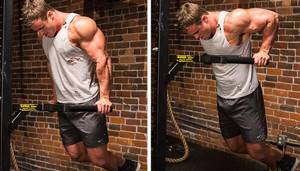
Pull-ups
Another option is pull-ups on parallel bars. It should not be confused with push-ups - they are different things. When doing pull-ups, the bars are grabbed with your hands, and your legs are above your head. They can be brought to the chest (baby pose) or straightened vertically upward, with the back parallel to the floor. Thus, you perform pull-ups to the stomach. The biceps receive the main load. The latissimus muscles, deltoids and abs are also involved, with the help of which we hold our legs above our heads.
What else is good about pull-ups?
Few people know the benefits of pull-ups on a horizontal bar.
You work with your body weight. The body is genetically optimized to work with its own weight. If you can do different strength exercises on the horizontal bar, then your muscles are in excellent condition. If not, it’s worth thinking about.
When you hang from the bar, your spine does not experience compression. On the contrary, it is stretched. This is useful from the point of view of preventing pinching and pinching. The muscles hold the vertebrae, pulling them towards each other, but if you relax, you can achieve a healing effect. If you work out in the gym and perform a vertical load with heavy weights, you must hang on the horizontal bar for at least 60 seconds a day, trying to completely relax your back and abs.
Of course, when you actively pull yourself up, you won’t be able to relax. But there is another feature here - firstly, you disperse blood throughout the body, and secondly, in fact, you remind the muscles why they are needed.
These are the benefits of pull-ups even without weights.
The benefits of pull-ups
Exercising on the crossbar has a positive effect on the condition of the body. Regular exercise can bring enormous benefits:
- Spine. Correct, even posture is formed. This is especially important for those who are used to slouching or are forced to be in an unnatural position for several hours every day. In addition, pull-ups help relax the spine.
- Back. Muscle tissues are pumped up. The back becomes sculpted and beautiful. The appearance is significantly improved.
- Hands. They are under the maximum load. Absolutely all muscles experience tension. Accordingly, their strength becomes much greater.
- Press. The load on the abdominal muscles is relatively small, but they can still be pumped up. For maximum effect, it is recommended to elevate your legs while hanging.
Pull-ups on the horizontal bar help prevent the development of osteochondrosis and scoliosis. Thanks to training, blood circulation is stimulated. All tissues receive proper nutrition, regeneration processes are accelerated. Capillaries and blood vessels are rapidly restored.

Pull-ups on the horizontal bar have a positive effect on the condition of the body
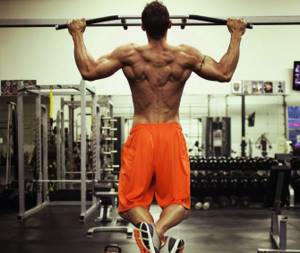
When doing pull-ups, the maximum load is placed on the arms
Precautionary measures
There are also a number of reasons why some people find pull-ups difficult. The main one is weak connective tissue, prone to injuries and sprains.
There is a solution, friends: warm up well and work very carefully with weights. The latter means that you need to add weight gradually. So gradually that your patience may not be enough. For example, you started doing pull-ups with 2 extra kg. Exercise with this weight for a week. Even if it becomes easy for you to exercise, increase the number of pull-ups, not the weight. After a week, add 1 kg. And so on. If you rush, you will get injured and forget about pull-ups for a long time.
Take warming up seriously. Without it, you risk injury.
The next problem that can lead to injury is a weak grip or a slippery bar. A weak grip needs to be strengthened - this is done by periodically hanging on the horizontal bar, using an expander or other exercises.
A slippery horizontal bar can prevent you from fully exercising. The solution is to use chalk, magnesium, or wear special gloves. Any of the above methods will help you.
How to learn to do a lot of pull-ups on the horizontal bar: scheme of actions
To master pull-ups from 0 you need to do the following:
1. Set a goal
Those. if you want to do 10 pull-ups in 15 days, write about it.
2. Make a clear action plan
It should include everything: from lead-in exercises and their technique to the number of approaches and training regimen.
3. Do at least one pull-up correctly.
Only after you have mastered the correct execution of the element can you move on and increase the number of repetitions.
4. Increase the number of repetitions evenly
Add at least one repetition every day.
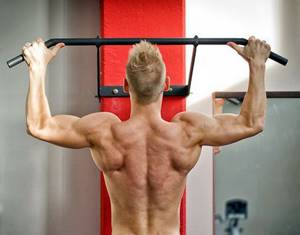
For beginners, you can propose the following scheme for achieving your goal, say, in one month:
| Day, week | Action |
| First day | Hanging on a bar, imitation of a pull-up, consisting of a slight lifting of the body with a delay at the top point. |
| First week | Full pull-ups with the support of a partner or with support on a stool. |
| Second week | A negative variation of the element that places the main emphasis on the descent technique. We need to take a position as if we had pulled ourselves up and begin a slow descent. |
| Third week | Alternate exercises from the first and second weeks. |
| Fourth week | Full pull-ups with a gradual increase in the number of repetitions to achieve your goal. |
What equipment can be used
In addition to using a stool or other elevated position, you can use auxiliary equipment to make the task easier, including TRX loops and an expander. Loops perform well when working with your own weight and allow you to master the element even faster.
Learning to pull yourself up with an elastic band
Expanders or rubber loops are widely used in mastering pull-ups. There is even a whole technique for performing an element with their help.
The technique consists of attaching one end of the elastic band to the crossbar and securing the other to one or two legs. The expander will take on part of the exerciser’s weight and help lift the body up.
To achieve maximum effect, you need to try your best, doing the last repetition at the limit of your ability. As soon as doing pull-ups with an elastic band seems easy, move on to performing a regular element. With the help of an expander, you can master both narrow and wide grip.
More information in the video:
The nuances of gaining mass on the horizontal bar
Pull-ups target the biceps, shoulders, and back. The lower back, legs, triceps do not experience stress. This means that only the arms in front and the back will develop.
In addition, weight gain will not proceed as quickly, since the load does not affect the entire muscle mass of your body.

It makes sense to add dips (chest and triceps) and hanging leg raises (abdominals) to your outdoor workouts.
But leg training gives a good increase in mass due to the production of large amounts of testosterone. Here the horizontal bar and parallel bars will no longer help. It's better to get a pair of good dumbbells or a barbell. Or go to the gym.
Be prepared for the fact that pull-ups alone will not increase the mass as much when performing a set of basic exercises with iron.
In conclusion, I would like to say that it happens that you do everything correctly, follow the technique. But you don’t have the perseverance to overcome yourself every time and go to training, despite laziness and other things. But then there will be no progress either. Remember that building muscle comes through discipline and perseverance. Push yourself, try to do more repetitions than you can. Constant self-education is the key to success!
Close-grip pull-ups
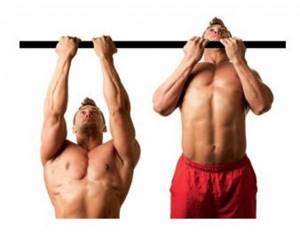
Main emphasis: lower lats, biceps.
Execution: grab the bar with a reverse grip, connecting the ribs of your palms together if possible. Hang on straight arms, arch your back and look at your hands. As you pull yourself up, focus on perfectly moving your shoulders back and squeezing your shoulder blades together. As you approach the top point, try to bend your back more and touch the bar with your lower pectoral muscles.
